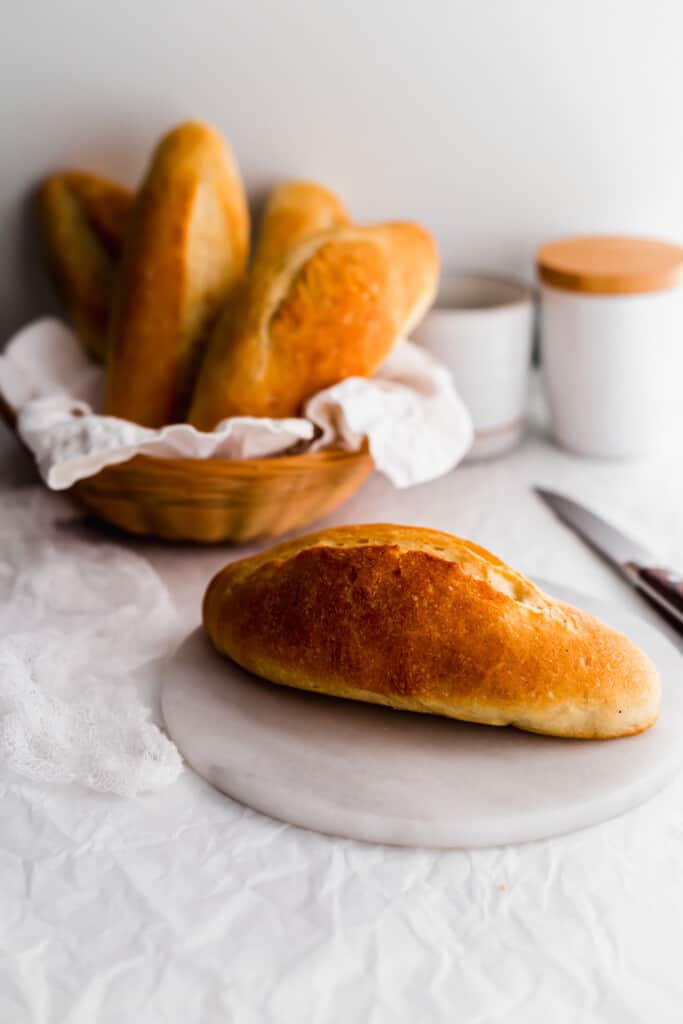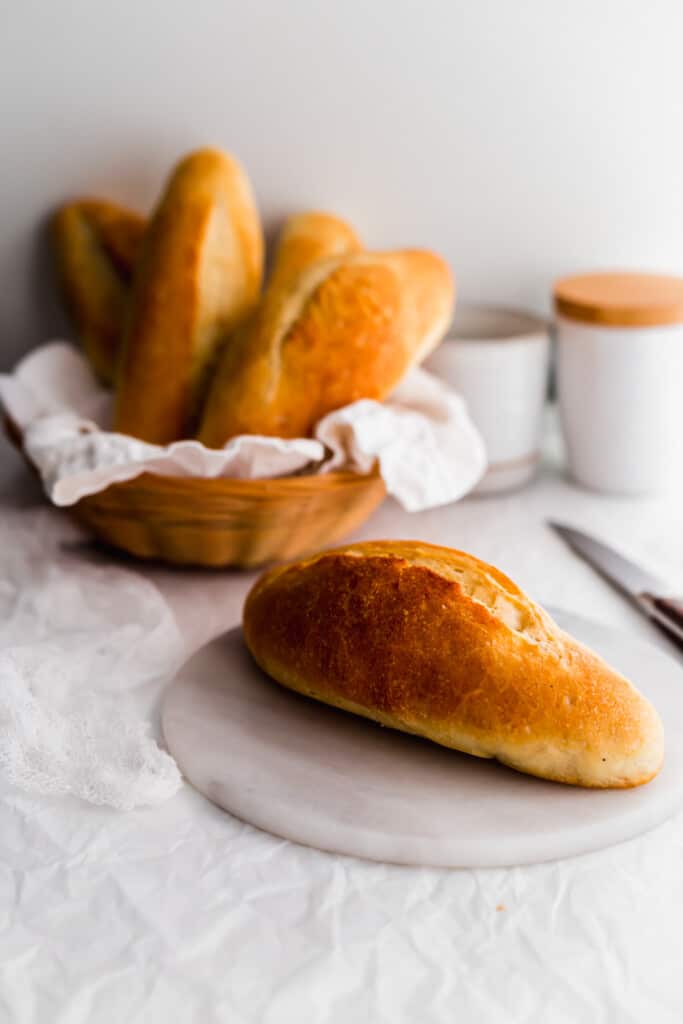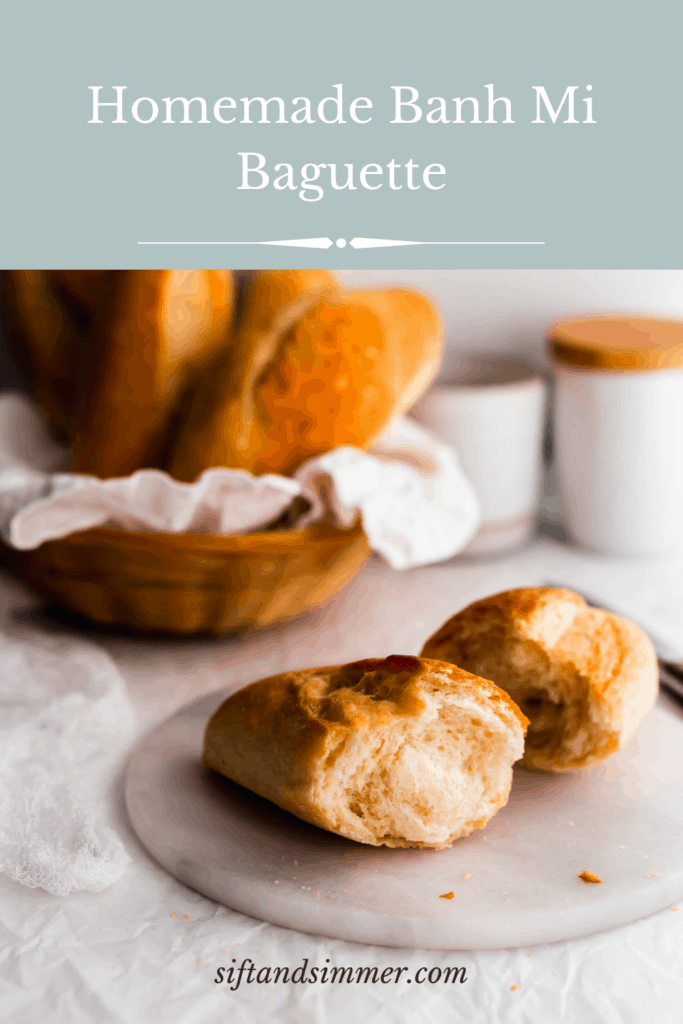- What is banh mi?
- History of banh mi
- What’s the difference between banh mi vs. French baguette?
- Ingredients you’ll need
- What about adding rice flour?
- Adding egg?
- Special equipment
- How to create steam
- How to make it
- Make the dough:
- Shape the dough:
- Preparing the oven:
- Baking the baguettes:
- Watch how to make it
- How to serve
- How to store and reheat
- Some notes to consider
- Other recipes you may like
This recipe for Homemade Banh Mi Baguette yields a soft and fluffy bread with a crusty exterior, perfect for banh mi sandwiches. With a few ingredients, you can easily make this Vietnamese staple at home.
 Banh mi sandwiches are one of my ultimate favourite foods to eat.
Banh mi sandwiches are one of my ultimate favourite foods to eat.
Bạn đang xem: bánh mì baguette
I recently got myself a baguette pan, and I’ve been experimenting with making homemade banh mi baguettes.
What is banh mi?
In Vietnamese, “banh mi” means “bread.”
It also refers to a savoury Vietnamese sandwich made with a crusty yet soft and airy baguette.
History of banh mi
The first baguettes were brought over to Vietnam by French colonists sometime in the early 1800s.
The French baguettes were eaten as a breakfast with some butter and sugar, jambon-beurre (ham & butter) with mayonnaise, or liver pate spread.
In the 1950’s, the banh mi (that we associate with today) was created in Saigon, and thus named “banh mi Sai gon.”
It became a popular and cheap street food, which has gained prevalence in North America.
What’s the difference between banh mi vs. French baguette?
The baguette used in a banh mi sandwich has a very crusty exterior, with a soft and light crumb.
It differs from the French baguette in that the French baguette has a more dense and chewier texture.
Ingredients you’ll need
- bread flour: has a higher protein content which produces gluten strands, which is needed for a soft and elastic dough. If you don’t have bread flour, you can use all-purpose flour, but be sure to knead the dough for the recommended time.
- active dry yeast: activate the yeast in lukewarm water, unless using instant yeast
- water: lukewarm water helps to activate the yeast
- salt: I used fine sea salt
- whole egg: I found I liked the texture of the interior crumb with the addition of the egg
- sugar: provides food for the yeast and promotes browning of the crust
- oil: helps with browning and adds moisture
What about adding rice flour?
It’s been long purported that rice flour is used in banh mi baguettes to give a lighter crumb. This is not necessarily true.
I tried this in the past and ended up with a pretty dense baguette – almost rock hard.
Perhaps in tropical climates, adding rice flour may help with excess moisture in the dough. But I wouldn’t recommend it.
Adding egg?
Traditionally, banh mi bread consists of only flour, yeast, water and salt.
However, I personally found through lots experimentation that I liked the texture of adding egg to the dough.
As with a brioche or enriched dough, egg adds a light and soft texture to the interior crumb.
Special equipment
- baguette pan
- dough scraper
- water spray bottle
- sharp serrated knife or bread lame
Baguette pan:
For this recipe, you’ll need a baguette pan.
It’s a pan with perforated wells that helps to shape the baguette while it is proofing.
You can do without, but it’s much easier with the baguette pan.
If you don’t have a baguette pan, shape the dough onto a rice flour covered-towel, and create a “couche” /well for each baguette for proofing.
Note: You’ll need to be careful when you transfer the shaped baguettes to the baking sheet for baking.
Dough scraper:
A silicone or metal dough scraper will help to divide the dough easily.
If you don’t have one, you can easily use a knife.
Đề xuất riêng cho bạn: Chỉ bạn 3 cách làm thịt kho ngon đậm đà với cách chế biến đơn giản
Water spray bottle:
A clean kitchen spray bottle is handy for baking bread and crusty loaves.
Misting the loaves in the hot oven creates additional steam, creating that crust that we’re looking for.
Note: I just dedicate a clean spray bottle with clean, boiled water for this purpose.
Sharp serrated knife:
Or bread/baking lame is required to make sharp slashes on the tops of the loaves, which prevent the bread from exploding or being mis-shapened.
How to create steam
The key to a baguette’s crisp and crusty exterior is steam, and lots of it.
To create steam in the oven, you’ll need a kitchen spray bottle (filled with clean water).
Once the baguettes are placed in the hot oven, quickly spray the baguettes with water.
The water instantly vaporizes into steam in the hot oven and creates that crusty texture for the banh mi.
That is in addition to a large pan filled with hot water that will sit on the bottom of the oven floor.
How to make it
Make the dough:
Measure out the warm water into a large measuring cup.
Add in the sugar and yeast. Give it a mix to activate the yeast.
Once the yeast is bubbly, add all the ingredients into a stand mixer bowl fitted with a dough hook.
Knead the dough until it is smooth and elastic, at least 10 minutes on a stand mixer at speed 3 or 4 (depending on your mixer’s horsepower).
The dough is ready when you can stretch a little bit of the dough between your fingers and it creates a thin “windowpane.”
Transfer the dough to a lightly oiled bowl and cover.
Let it rest in a warm location, until doubled in size.
Shape the dough:
Once risen, divide the dough into 6 equal triangular portions (Step 1 above).
Slap the dough to release any air bubbles and shape into a triangle.
Start from the “pointy” end of the triangle and roll and pinch the sides, while working your way down (Step 2).
Seal the ends and place onto a perforated baguette pan (Step 3).
Repeat with the remainder.
Cover lightly with a damp cloth and leave to rise in a warm location, until puffy and almost doubled in size.
Preparing the oven:
Towards the end of the proofing time, preheat oven to 425F.
Adjust the oven rack to the 3rd from the bottom.
Tham khảo thêm: Dành cho bạn Top những cách làm pizza chay vừa ngon vừa hấp dẫn ngay tại nhà
Carefully add a large roasting pan filled with hot boiling water to the bottom rack of the oven.
Baking the baguettes:
Spray the baguettes with water using a clean kitchen spray bottle.
Make a swift yet controlled slash at a 45 degree angle on each baguette with a sharp knife or baking lame (Step 4).
Spray the tops of the baguettes with water again.
Place the baguettes into the oven and quickly spray the baguettes with water (to create steam) before shutting the oven door.
Bake for a total of 22 minutes. Every 2 minutes, open the oven door and spray the baguettes with water, until 6 minutes have elapsed (do this 3 times, every 2 minutes).
When there is 10 minutes left in the baking time, carefully remove the roasting pan with hot water and let the baguettes continue to bake.
Cool the baguettes completely on a wire rack before slicing.
Watch how to make it
How to serve
Serve the homemade banh mi baguettes in a Cold Cut Banh Mi sandwich, or with a hearty stew such as bo kho.
The banh mi baguette is best enjoyed on the same day it’s baked.
How to store and reheat
Store the leftover baguettes in a paper bag for up to 1 day.
Otherwise, transfer to a freezer-safe bag store in the fridge for up to 1 week or freezer for up to 1 month.
To reheat, simply place the baguettes in a 350F oven for 10-12 minutes, until warm and crisped up.
Some notes to consider
Each oven will vary in temperature and heat intensity.
You may need to play around with your oven’s temperature, as well as the positioning of your oven rack.
I found that this combination worked the best for my own oven, but it may be different for you.
Other recipes you may like
Be sure to try these other recipes:
Cold Cut Banh Mi Vietnamese Sandwich
Airy Baguette
Vietnamese Iced Coffee
Do Chua (Vietnamese Pickled Daikon & Carrot)
Vietnamese Salad Rolls (Goi Cuon)
Grilled Lemongrass Turkey Banh Mi
Let me know if you try out this recipe for banh mi baguette. Tag me on Instagram @siftandsimmer or leave me a comment below!


Recipe adapted from Aimee’s Cooking.